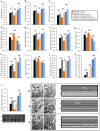The activation of cardiac dSir2-related pathways mediates physical exercise resistance to heart aging in old Drosophila
- PMID: 31503544
- PMCID: PMC6756900
- DOI: 10.18632/aging.102261
The activation of cardiac dSir2-related pathways mediates physical exercise resistance to heart aging in old Drosophila
Abstract
Cardiac aging is majorly characterized by increased diastolic dysfunction, lipid accumulation, oxidative stress, and contractility debility. The Sir2/Sirt1 gene overexpression delays cell aging and reduces obesity and oxidative stress. Exercise improves heart function and delays heart aging. However, it remains unclear whether exercise delaying heart aging is related to cardiac Sir2/Sirt1-related pathways. In this study, cardiac dSir2 overexpression or knockdown was regulated using the UAS/hand-Gal4 system in Drosophila. Flies underwent exercise interventions from 4 weeks to 5 weeks old. Results showed that either cardiac dSir2 overexpression or exercise remarkably increased the cardiac period, systolic interval, diastolic interval, fractional shortening, SOD activity, dSIR2 protein, Foxo, dSir2, Nmnat, and bmm expression levels in the aging flies; they also notably reduced the cardiac triacylglycerol level, malonaldehyde level, and the diastolic dysfunction index. Either cardiac dSir2 knockdown or aging had almost opposite effects on the heart as those of cardiac dSir2 overexpression. Therefore, we claim that cardiac dSir2 overexpression or knockdown delayed or promoted heart aging by reducing or increasing age-related oxidative stress, lipid accumulation, diastolic dysfunction, and contractility debility. The activation of cardiac dSir2/Foxo/SOD and dSir2/Foxo/bmm pathways may be two important molecular mechanisms through which exercise works against heart aging in Drosophila.
Keywords: dSir2; exercise; heart aging; lipid accumulation; oxidative stress.
Conflict of interest statement
Figures







Similar articles
-
Endurance exercise resistance to lipotoxic cardiomyopathy is associated with cardiac NAD+/dSIR2/PGC-1α pathway activation in old Drosophila.Biol Open. 2019 Oct 17;8(10):bio044719. doi: 10.1242/bio.044719. Biol Open. 2019. PMID: 31624074 Free PMC article.
-
dSir2 and longevity in Drosophila.Exp Gerontol. 2011 May;46(5):391-6. doi: 10.1016/j.exger.2010.08.007. Epub 2010 Aug 20. Exp Gerontol. 2011. PMID: 20728527 Free PMC article. Review.
-
Increased expression of Drosophila Sir2 extends life span in a dose-dependent manner.Aging (Albany NY). 2013 Sep;5(9):682-91. doi: 10.18632/aging.100599. Aging (Albany NY). 2013. PMID: 24036492 Free PMC article.
-
Activation of cardiac Nmnat/NAD+/SIR2 pathways mediates endurance exercise resistance to lipotoxic cardiomyopathy in aging Drosophila.J Exp Biol. 2021 Sep 15;224(18):jeb242425. doi: 10.1242/jeb.242425. Epub 2021 Sep 15. J Exp Biol. 2021. PMID: 34495320
-
The effects of Rpd3 on fly metabolism, health, and longevity.Exp Gerontol. 2016 Dec 15;86:124-128. doi: 10.1016/j.exger.2016.02.015. Epub 2016 Feb 27. Exp Gerontol. 2016. PMID: 26927903 Free PMC article. Review.
Cited by
-
Drosophila exercise, an emerging model bridging the fields of exercise and aging in human.Front Cell Dev Biol. 2022 Sep 9;10:966531. doi: 10.3389/fcell.2022.966531. eCollection 2022. Front Cell Dev Biol. 2022. PMID: 36158212 Free PMC article. Review.
-
Regular Exercise in Drosophila Prevents Age-Related Cardiac Dysfunction Caused by High Fat and Heart-Specific Knockdown of skd.Int J Mol Sci. 2023 Jan 7;24(2):1216. doi: 10.3390/ijms24021216. Int J Mol Sci. 2023. PMID: 36674733 Free PMC article.
-
Physical exercise prevents age-related heart dysfunction induced by high-salt intake and heart salt-specific overexpression in Drosophila.Aging (Albany NY). 2021 Aug 12;13(15):19542-19560. doi: 10.18632/aging.203364. Epub 2021 Aug 12. Aging (Albany NY). 2021. PMID: 34383711 Free PMC article.
-
Role of muscle FOXO gene in exercise against the skeletal muscle and cardiac age-related defects and mortality caused by high-salt intake in Drosophila.Genes Nutr. 2023 Mar 30;18(1):6. doi: 10.1186/s12263-023-00725-2. Genes Nutr. 2023. PMID: 36997839 Free PMC article.
-
Downregulation of MLF1 safeguards cardiomyocytes against senescence-associated chromatin opening.Nucleic Acids Res. 2025 Jan 11;53(2):gkae1176. doi: 10.1093/nar/gkae1176. Nucleic Acids Res. 2025. PMID: 39657728 Free PMC article.
References
-
- McCullough PA, Philbin EF, Spertus JA, Kaatz S, Sandberg KR, Weaver WD, and Resource Utilization Among Congestive Heart Failure (REACH) Study. Confirmation of a heart failure epidemic: findings from the Resource Utilization Among Congestive Heart Failure (REACH) study. J Am Coll Cardiol. 2002; 39:60–69. 10.1016/S0735-1097(01)01700-4 - DOI - PubMed
Publication types
MeSH terms
Substances
LinkOut - more resources
Full Text Sources
Medical
Molecular Biology Databases

